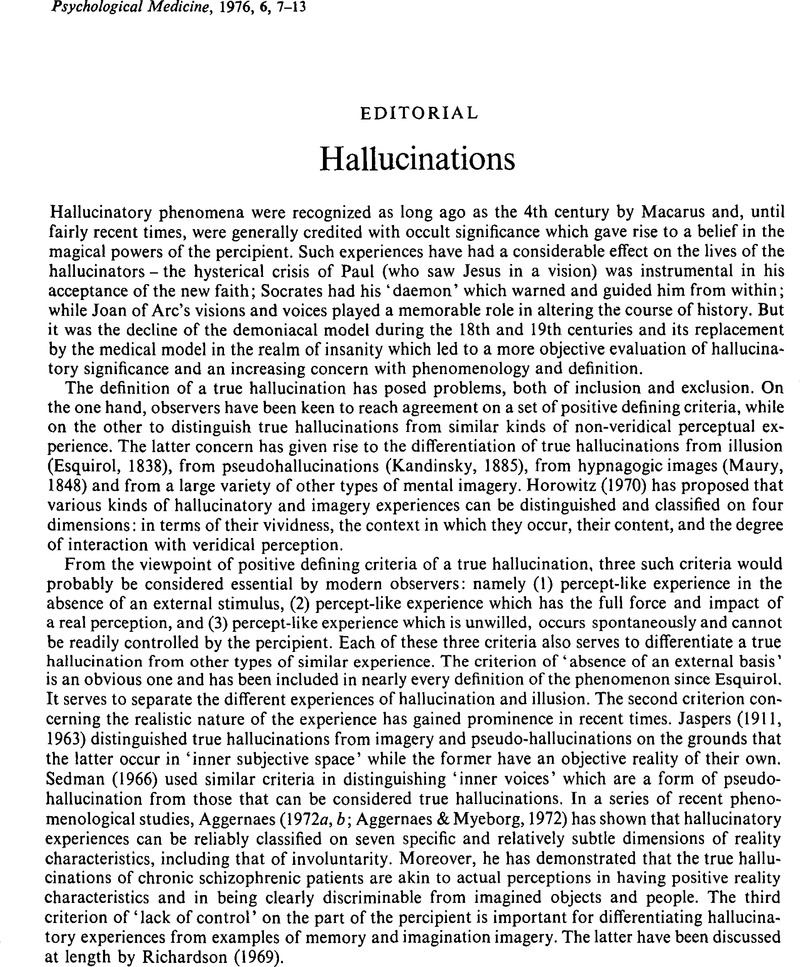Crossref Citations
This article has been cited by the following publications. This list is generated based on data provided by Crossref.
Slade, P. D.
1976.
An investigation of psychological factors involved in the predisposition to auditory hallucinations.
Psychological Medicine,
Vol. 6,
Issue. 1,
p.
123.
Jefferson, James W.
and
Marshall, John R.
1981.
Neuropsychiatric Features of Medical Disorders.
p.
1.
EASTWOOD, M. R.
and
CORBIN, S.
1983.
Hallucinations in Patients Admitted to a Geriatric Psychiatry Service.
Journal of the American Geriatrics Society,
Vol. 31,
Issue. 10,
p.
593.
Garralda, M. E.
1984.
Hallucinations in children with conduct and emotional disorders: II. The follow-up study.
Psychological Medicine,
Vol. 14,
Issue. 3,
p.
597.
de Silva, Padmal
1986.
Obsessional-compulsive imagery.
Behaviour Research and Therapy,
Vol. 24,
Issue. 3,
p.
333.
1986.
Hallucinations: theoretical and clinical overview.
American Journal of Psychiatry,
Vol. 143,
Issue. 9,
p.
1088.
Hare, Edward
1987.
Commentary One.
Australian & New Zealand Journal of Psychiatry,
Vol. 21,
Issue. 3,
p.
315.
Soni, Som D.
1988.
Relationship between peripheral sensory disturbance and onset of symptoms in elderly paraphrenics.
International Journal of Geriatric Psychiatry,
Vol. 3,
Issue. 4,
p.
275.
Garralda, M.Elena
and
Watt, Alison E.
1989.
Seasonal variations in the child and adolescent psychoses.
Journal of Adolescence,
Vol. 12,
Issue. 3,
p.
315.
Carter, Jerry L.
1992.
Visual, Somatosensory, Olfactory, and Gustatory Hallucinations.
Psychiatric Clinics of North America,
Vol. 15,
Issue. 2,
p.
347.
1992.
Visual hallucinations in patients with macular degeneration.
American Journal of Psychiatry,
Vol. 149,
Issue. 12,
p.
1701.
Howard, Robert
and
Levy, Raymond
1994.
Charles bonnet syndrome plus: Complex visual hallucinations of charles bonnet syndrome type in late paraphrenia.
International Journal of Geriatric Psychiatry,
Vol. 9,
Issue. 5,
p.
399.
Líndal, Eiríkur
Stefánsson, Jón G.
and
Stefánsson, Sigurjón B.
1994.
The qualitative difference of visions and visual hallucinations: A comparison of a general-population and clinical sample.
Comprehensive Psychiatry,
Vol. 35,
Issue. 5,
p.
405.
Hunter, Ella Price
and
Storat, Betty
1994.
Psychosocial Triggers of Relapse in Persons with Chronic Mental Illness: A Pilot Study.
Issues in Mental Health Nursing,
Vol. 15,
Issue. 1,
p.
67.
Holroyd, Suzanne
1996.
Visual Hallucinations in a Geriatric Psychiatry Clinic: Prevalence and Associated Diagnoses.
Journal of Geriatric Psychiatry and Neurology,
Vol. 9,
Issue. 4,
p.
171.
Fennig, Shmuel
Susser, Ezra S.
Pilowsky, Daniel J.
Fennig, Silvana
and
Bromet, Evelyn J.
1997.
Childhood Hallucinations Preceding the First Psychotic Episode.
The Journal of Nervous & Mental Disease,
Vol. 185,
Issue. 2,
p.
115.
Brasić, James Robert
1998.
Hallucinations.
Perceptual and Motor Skills,
Vol. 86,
Issue. 3,
p.
851.
Mahowald, Mark
and
Schenck, Carlos
1999.
Sleep Disorders and Neurological Disease.
England, Margaret
Rubenstein, Linda
and
Tripp-Reimer, Toni
2003.
Relevance of Cues for Assessing Hallucinated Voice Experiences.
International Journal of Nursing Terminologies and Classifications,
Vol. 14,
Issue. 3,
p.
77.
England, Margaret
Rubenstein, Linda
and
Tripp‐Reimer, Toni
2003.
Relevance of Cues for Assessing Hallucinated Voice Experiences.
International Journal of Nursing Terminologies and Classifications,
Vol. 14,
Issue. 3,
p.
77.



